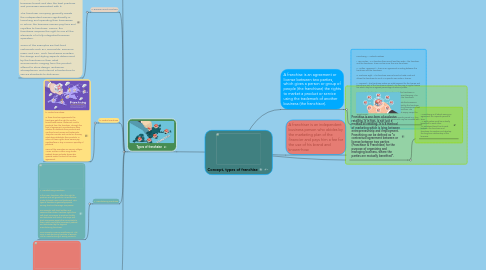
1. Types of franchaise
1.1. Franchising – 4 Major Types of Franchises:
1.2. a. Business Format Franchises
1.2.1. a. Business Format Franchises: This is the most common type of franchise. Here a company expands by supplying an established business concept/format, including its brand name, symbol, and/or trademark to independent business owners. In this arrangement, the franchisee acquires the right to use or follow a business format and also the best practices and processes associated with it. The franchiser company generally assists the independent owners significantly in launching and operating their businesses. In return, the business owners pay fees and royalties to franchiser. Hence, the franchisee acquires the right to use all the elements of a fully integrated business operation. Some of the examples are fast-food restaurants such as McDonald’s, Domino’s Pizza, and KFC. Such franchisees maintain the design and styling aspects determined by the franchiser in their retail environments, ranging from the product offered to store design, ambience, atmospherics, and internal infrastructure to service standards to deliveries.
1.3. b. Product Franchises
1.3.1. b. Product Franchises: In these franchise agreements, the franchisee gets the right to use the brand/trade names, trademark, and/or products from the franchiser. Through this kind of agreement, manufacturers allow retailers to distribute their products and use their brand names and trademarks. They also monitor and control on the way retail stores distribute their products. In return of these rights, store owners pay royalties/fees or buy a minimum quantity of products. Some of the examples are Tommy Hilfiger, Arrow, Scullers, Cotton King Stores, Reebok stores and Bata stores who operate under this kind of franchise agreement.
1.4. c. Manufacturing Franchises
1.4.1. c. Manufacturing Franchises: In this case, franchiser offers the right to produce and sell goods to a manufacturer under its brand name and trademark. This type of franchise is generally popular among food and beverage companies. For example, soft drink bottlers and canners often obtain franchise rights from soft drink companies to produce, bottle, and distribute soft drinks. The major soft drink companies supply the concentrate to them, which are further processed, packed, and distributed by the regional manufacturing franchises. One example is Gemini Distilleries Pvt. Ltd, Goa, a manufacturing franchise of Bacardi Ltd for manufacturing of winery products.
1.5. d. Business Opportunity Ventures
1.5.1. d. Business Opportunity Ventures: This concept works on the format in which an independent business owner buys and distributes the products from one company. The company supplies the business owner with clients or accounts, in return of which the business owner pays the company a pre-decided fee. For example, the business owners may obtain vending machine routes and distribution rights, through this type of franchise arrangement (e.g., coffee vending machine). Retailer brands and companies often look toward franchising as a key operating model for expansion from scale, geographical coverage, and time perspectives. For example, Gap is looking forward to script a new story in India as it struggles to maintain customer loyalty in markets across the world. The company was set up in 1969 by Doris and Donald Fisher and has presence in around in 90 countries through around 3,300 company- operated stores and 400 franchise stores.
